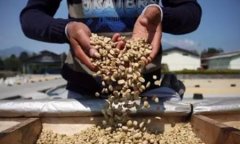Colombia Hope Manor's boutique coffee beans introduction Coffee Manor Hope Manor production
Ten years ago, when most coffee farms in Colombia went all out to sprint production, and the government advocated high-yield, disease-resistant, and discouraged beans with good flavor but low yield, Cafe Granja La Esperanza was determined to embark on the long road of fine coffee.
I hope the coffee of four different tree species under the manor can make you understand the influence of "tree species" on flavor.
1 Geisha/ high altitude rose summer 1500mm 2000m
Flavor: ginger, lemon, orange, jasmine white flowers, high sweetness
2 Bourbon Amarillo/ yellow bourbon
Flavor: chocolate, caramel, baked cookies, excellent balance
3 Caturra/ Kaddura
Flavor: roasted wheat, slightly lower acidity, round
4 Bourbon pointed body Bourbon Pointu/Laurina
Chocolate, vanilla, caramel, plum fruit
The opportunity that I hope the manor will see at that time is "Geisha". After the Panamanian Emerald Manor became famous because of the rediscovery of rose summer in the garden, coffee farms around the world were studying the possibility of planting rose summer, but there was no rose summer variety in Colombia. It was hoped that the manor owner Rigoberto Herrera sent the chief botanist Hernando Tapasco to Panama to study, rented La Cardeida Farm next door to Bogut Emerald Manor, and Tapasco himself spent a year in Boquette. Thoroughly study the planting and production technology of Rosa rugosa.
In December 2006, Manor Hope bought the Cerro Azul in Colombia's Cauca Valley, the geographical environment is very close to Poquette, the warm air rising from the Cauca Valley and the cold air from the Pacific meet at the manor, creating an excellent evapotranspiration (an important factor for plant growth). In the harvest season of 2012, he won the second place in the annual World Coffee Competition of the American Fine Coffee Association, and the rosy summer of the other two estates of Hope Manor, and took three places in the top 10: 2nd, 3rd and 7th, creating an incredible triple crown (Triple crown)!
Hernando Tapasco's team, the lead botanist, set up a climate station on the estate to track weather data and help make harvest decisions. The data on the farm were collected continuously and analyzed once a week. After harvest, they will compare weather data, production data, cup test data, and analyze the correlation. The harvesters of Rose Summer are strictly trained to collect only ripe cherry fruits and are paid by the day, unlike other manors by weight. In order to prevent workers from harvesting unqualified cherries in order to improve their performance, half of the harvesting workers have more than six years of experience. After the fruit is harvested, it is sent to the central processing plant in Hope Manor, and each batch of rose summer will be marked and dealt with separately.
Hope Manor's experiment and innovation in variety seems endless, constantly experimenting with different new varieties, except for the organic Kaddura (Caturra), which used to occupy most of the area in Hope Manor, from Rose Summer, Organic Rose Summer, Moka, Bourbon. Including red, yellow, Tekizik bourbon, pointed bourbon (Laurina), Pacamara (Pacamara), San Bernardo (San Bernardo) and Pache, they really bring the winery's serious attitude towards grape varieties to coffee. After the rose summer, from the Pacamara, Bourbon and even the pointed Bourbon produced by the Hope Manor, continue to create the surprise and admiration of the boutique coffee world.
What is particularly worth mentioning is the bean of dreams-pointed bourbon.
The legendary Bourbon pointed Coffee is a natural variant found on the island of Bourbon. In the 18th century, the output of this high-end coffee, which was popular in Europe, reached 4000 tons, but in 1942, only 200kg was left. after the 20th century, this natural low-caffeinated coffee with excellent flavor disappeared from the market completely or even disappeared for a time because of diseases and insect pests and economic factors. Fortunately, Japan's Yoshiaki Kawashima believed in the legend and visited the legendary coffee in the country of origin "Bourbon Island" in 1999, and then successfully restored it in 2006 with the cooperation of French research units and Japan, harvesting the first batch of reborn bourbon spikes. In 2007, this batch of bourbon pointed bodies were launched in 100g packaging by UCC of Japan in Tokyo, with a price of nearly 8,000 yen, which was swept away and shocked the world. Since then, famous manors around the world have begun to study the planting of this rare tree species.
Bourbon pointed body Bourbon Pointu is French, take its raw bean-shaped tip, the scientific name is Laurina, caffeine content is only between 0.4% and 0.75%, the general Arabica caffeine content is about 1.2% to 1.6%, the difference is very large, so it is claimed to drink coffee that will not be sleepless. As a coffee species, Laurina has dense leaves and slow ripening cherries, so the sweetness can be fully developed. The cup test flavor shows bright sour taste, low bitterness, charming and meticulous aroma.
Important Notice :
前街咖啡 FrontStreet Coffee has moved to new addredd:
FrontStreet Coffee Address: 315,Donghua East Road,GuangZhou
Tel:020 38364473
- Prev

Introduction of boutique coffee bean manor-- Panamanian coffee producing area Panamanian boutique coffee introduction coffee
The coffee grown in the highland is absolutely high quality, but the plantation coffee is not yet on the market. Panama coffee is smooth, light and sour, and its high-quality coffee beans are pure and distinctive. The first batch of coffee exported each year is shipped in November, and almost all high-quality coffee beans are shipped to France and Finland. The finest coffee is grown in the north of the country, near Costa Rica
- Next

Introduction of high-quality coffee beans and high-quality coffee in Diamond Manor of Huilan Plateau, Colombia
Country: Columbia altitude: 1667m production area: Vera plateau treatment: peel dry fermentation four times washing varieties: yellow bourbon producer: Diamond Manor flavor: hazelnut, pistachio, caramel sweetness, cream texture Colombian coffee dates back to 1808. A priest brought coffee to Colombia for the first time from the French Antilles via Venezuela. Goran.
Related
- Does Rose Summer choose Blue, Green or Red? Detailed explanation of Rose Summer Coffee plots and Classification in Panamanian Jade Manor
- What is the difference between the origin, producing area, processing plant, cooperative and manor of coffee beans?
- How fine does the espresso powder fit? how to grind the espresso?
- Sca coffee roasting degree color card coffee roasting degree 8 roasting color values what do you mean?
- The practice of lattes: how to make lattes at home
- Introduction to Indonesian Fine Coffee beans-- Java Coffee producing area of Indonesian Arabica Coffee
- How much will the flavor of light and medium roasted rose summer be expressed? What baking level is rose summer suitable for?
- Introduction to the characteristics of washing, sun-drying or wet-planing coffee commonly used in Mantenin, Indonesia
- Price characteristics of Arabica Coffee Bean Starbucks introduction to Manning Coffee Bean Taste producing area Variety Manor
- What is the authentic Yega flavor? What are the flavor characteristics of the really excellent Yejasuffi coffee beans?

